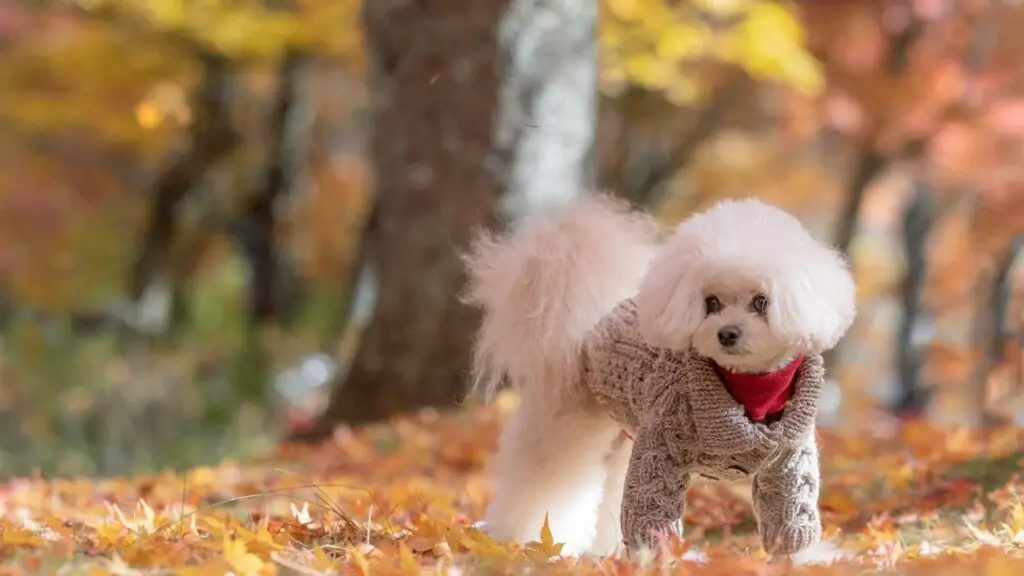Did you know you could breed a Chihuahua and a poodle? Well, if you didn’t, you do now! This breed is commonly known as Chipoo, Choodle, Poochi, and a Poohuahua. In particular, its poodle parent is either a toy or teacup poodle.

Like other poodle hybrids, a Chipoo originates from the United States, and it’s believed they were first bred during the 1970s, 10 years later than when the Cockapoo.
Their ancestor, the poodle, originated from Germany and came into existence around the 13th century, and the toy breed is rumored to have come from the U.K in the 18th century. Moreover, the Chihuahua is thought to have come from Mexico during the 10th-12th century.

Read our Smart Poodles - Smart Tricks eBook for only $2.99
Dive into a treasure trove of engaging tricks and tips designed specifically for your poodle!
Due to its inheritance, the Chipoo is known as a designer dog. However, the American Kennel Club does not recognize it as a purebred. A Chihuahua poodle mix can weigh anything between 5-20 pounds, and height can be anywhere from 5-20 inches.
What Will You Learn? 👇
What does a chihuahua poodle mix look like?
Chihuahua and Poodles are both adorable and charming dogs. We assure you, once they’re characteristics are combined to form a Chipoo, your heart will melt from the cuteness.
A Chipoo has distinct features such as its apple-shaped head (if it takes after it’s Chihuahua parent), or it could have a round head with a long nose (if it inherits characteristics from its poodle parent).

You will find this breed comes in a range of colors and can have different coats varying from white color, apricot brown, black, fawn, and more. Depending on their inheritance, you may find them having one color like a poodle or several colors on their bodies, like a Chihuahua.
Similarly, the dog’s shape can vary; if a Chippo inherits more from its Poodle parent, expect its shape to be long and slim. Whereas if they inherit from a Chihuahua, you will find the Chipoos shape short and chunky.
Are Chipoos hypoallergenic?
A fantastic feature about the Chipoo is that it’s somewhat hypoallergenic. We say this because Chipoos don’t shed often; only when it’s a change of season will you find them to shed more hair than usual.
That does not mean you will have no allergic reactions to them though, everyone is different, and you could become allergic to their hair or saliva.
To know if you’re allergic to a Chipoo or not, we recommend consulting your doctor first and get an allergy test to see if you react.

Also, just because they don’t shed often does not mean you shouldn’t groom them. Chipoos require regular stimulation to their skin, which means frequent brushing. Likewise, it stops their coats from getting tangled or matted.
Do expect to brush your Chipoo more during the shedding seasons using a soft-bristled brush. You will also want to bathe your Chipoo time and again to get rid of any excess loose hair, do this every 4-8 weeks.
How big do they get?
Chipoos are not a tall breed, as the Chihuahua and poodle are both small in height. Therefore their height generally ranges from 5-15 inches. They are closely related in size to other doodle breeds like the Pugapoo or the French Boodle, so make sure you check them out also.
Do they shed?
Chipoos hardly shed, only when it comes to a change of season. Even though they don’t shed much, as a dog owner, you should still brush its hair to ensure it’s in good condition between 1-3 times a week. If you do this, this will remove any tangles and matts from the hair, keeping its coat smooth.
How to train a chipoo puppy?
We cannot stress enough; a Chipoo must be trained to learn manners and good etiquette and is trained young. At first, it may be hard work and challenging initially; however, we can assure you, you will benefit from this later on.
When you train your dog, make sure you never shout at it or hit it, as negative behavior is similar to abuse and can invoke a sense of fear into your Chipoo. The best way to train them is through positive reinforcement, rewarding your dog with a treat or loving gesture every time they perform good behavior.

When it’s young, you must take it out for regular walks on a leash and make sure it becomes acquainted with other humans and dogs. A Chipoo can become possessive over its belongings, especially toys, from an early age. If it becomes used to socializing while young, then it will be less likely to become aggressive towards others when older.
Sometimes Chippos can show a stubborn persona when young, and it can become frustrating. Therefore we advise you to observe Chippos behavior and coach it from an early age when possible, so it knows the right etiquette.
Moreover, potty training a Chippo can be done by using the crate training method. By simply purchasing a crate can help relieve their anxiety, get them acquainted with sleeping on their own, and allow them to use the bathroom when required (instead of leaving a mess).
If you have a difficult time training your Chipoo there are also puppy schools where you can send them and have professionals train them. If you take them to a school, this also helps them socialize too.
Are Chipoos good for first time owners?
No doubt, Chipoos can be an active, friendly, and energetic dog to own. However, just because they have this temperament, does not always mean they are the perfect breed for those who want to own a dog for the first time.
We say this because they have a stubborn personality, and if you don’t have experience looking after or tending to dogs, this can be a complex challenge for you to train them.
Do Chipoos have health problems?
If you own or are considering purchasing a Chipoo, you’ll be pleased to know that they don’t suffer from many health problems. However, because they’re a cross breed, they could be prone to inheriting their parents’ problems. Typically you could find a Chipoo inheriting the following:
Overactive tear glands– The small outer part of a Chippos eye is known as the lacrimal gland, and this can cause tears in front of the eye when blinking.
Glaucoma- If inherited, Chippos can experience a large amount of pressure in their eye result in Glaucoma, impairing their vision, and can, at the worst, lead to blindness.
Hypoglycemia- The Chihuahua can be prone to having little fat stores and developing low blood sugar levels leading to Hypoglycaemia. As a result, Chipoos can also inherit the same features and cause them to collapse, have seizures, tremors, weakness, or impaired vision.

Luxating patellas- Due to their small breed, sometimes a Chipoos thighbone can go out of line. This could happen in one or both of their hind legs. As a result, they can suffer from walking problems and be in lots of pain as they grow older.
Periodontal disease- Small breeds are susceptible to getting periodontal disease. This disease causes a lot of plaque and tartar to build up in their teeth, causing gum problems and bad breath. You can prevent this by brushing your Chipoos teeth often and giving it dry kibble to eat.
Mitral Valve disease– Sometimes Chipoos can inherit a heart disease known as Mitral Valve disease. This is when the heart reduces the blood flow and does not flow correctly to the body. Unfortunately, there is no cure, only x-rays and ECGs can detect it, and medication can slow the process down.
How long do Chihuahua poodle mixes live?
You will find that the Chihuahua poodle mix has a lifespan of 12-15 years. That is given you raise it in a loving environment, where it’s well fed, looked after, and has space to grow. There have been some cases where this crossbreed has lived up to 20 years.
How much does a Chipoo puppy cost?
Prepare to be gobsmacked. A Chipoo is not a cheap dog to buy; in fact, buying one may remove a hefty sum from your bank balance. Typically you will find a Chipoo to cost anything from $500 to $4,000 or more!

The price of owning a Chipoo can vary based on their bloodline, the breeder, coat, temperament, location, and much more. Whether you pay a smaller or larger price, we recommend asking the breeder or the seller for their medical records to know what you’re getting.
Be cautious of scams as well as showcasing adverts for selling Chipoos showing a lot of rescue puppies. Similarly, as this is a designer breed, many bad people are trying to inhumanely breed Chipoos, raising them in a puppy farm.
If you want to buy a Chipoo be sure you have ample savings for its vet bills too. Over its lifetime, you will need to pay for its food, vaccinations, deworming, flea control, dental bills, training, toys, and supplies. Because of this, it may cost anything from $500-$2000 to maintain and look after a Chipoo each year.
Final Thoughts
Chipoos first originated from the United States in the 1970s and have become popular worldwide ever since. What’s fantastic about this crossbreed is that they hardly ever shed and don’t have that many health problems. If they do, they’ve most likely inherited them from their parents, the Chihuahua and the Poodle.
When they’re young, they can develop quite a stubborn temperament; therefore, they’re not an ideal dog to have for first-time pet owners. It’s best to socialize them from a young age and train them using positive reinforcement techniques to remove this.
Other methods of training that are useful are crate training for the toilet and sleeping. Similarly, if you struggle training them, it’s best to take them to a puppy school to learn the correct behaviors and socialize from an early age.
They don’t shed often and, as a result, may not trigger many allergies. While this may be the case, we cannot predict others from being allergic to their saliva or hair. Likewise, we recommend that you think that you might suffer from allergies and get tested before owning a Chipoo.
Finally, we think Chipoos are fun to be around and incredibly cute to look at. Plus, they have so many unique qualities about them.
Do you own a Chipoo or love them like us? Let us know your favorite features about them below.
Marko is the founder and author at PoodleHQ, where he blends profound expertise with formal training in Animal Behavior and Canine Genetics. With multiple generations of poodles under his care, he’s a breed connoisseur, honored with the Canine Care Excellence Award and lauded by the International Pet Enthusiasts Association.

